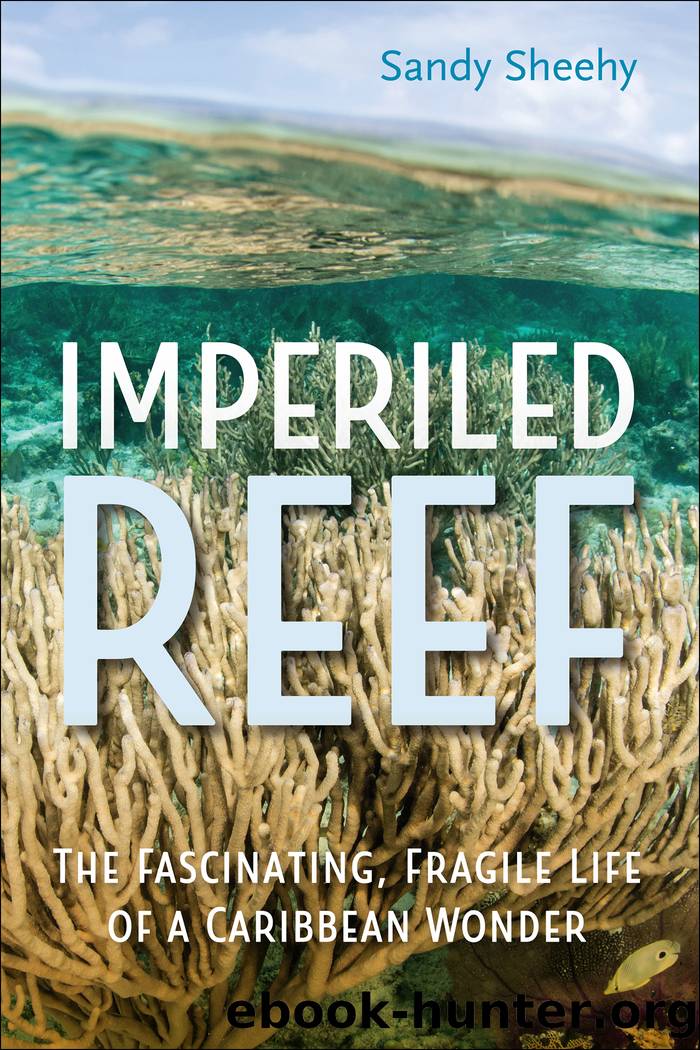Imperiled Reef by Sandy Sheehy;

Author:Sandy Sheehy;
Language: eng
Format: epub
Publisher: University Press of Florida
Published: 2021-06-15T00:00:00+00:00
III
WHAT WORKS
Joining Forces to Save the Reef
15
INVASION OF THE LIONFISH
It was happy hour at Hamanasi, an upscale eco-resort on the Belize coast about 120 miles south of Belize City. The bar was large and airy, with couches and chairs upholstered in tropical prints and arranged in conversation groups. A bookcase stocked with board games and jigsaw puzzles sat against one wall, and two sets of French doors led out to the verandah and the lighted pool beyond. Behind a curving bar crafted of sustainable hardwood, the best mixologist in this part of the country was filling a silver shaker with the ingredients of the drink of the day, a concoction involving coconut rum, vodka, fresh pineapple juice, and blue curaçao.
Although the place was usually busy, this evening it was packed. Free appetizers provided the lure, and the head cook had laid them out on a table brought in for the purpose. Neatly lettered signs identified each snackâlionfish fingers, lionfish cakes, lionfish balls, lionfish ceviche. Various dipping saucesâbuffalo-wing style, barbecue, jerk, mustard, sweet-and-sourârounded out the presentation. The intention was clear: Get the barâs patrons to try the mild, slightly sweet-tasting meat of this fish, an invasive species with a stunning rate of reproduction and no natural enemies in the Caribbean. Once guests had sampled lionfish, they would be more inclined to order it as fish tacos at lunch or as the catch-of-the-day at dinner.
Lionfishes (red lionfish: Pterois volitans and its cousin the common lionfish or devil firefish: Pterois miles) are a prime example of how human thoughtlessness can disrupt a fragile ecosystem and how human ingenuity and cooperation may be able to controlâor at least reduceâthe damage. Although they are native to the Indo-Pacific, specifically to the tropical waters surrounding the Philippines, Indonesia, and the islands of the South Pacific,1 in the early 1990s lionfishes began appearing in South Florida. The first confirmed sighting, in 1985, was treated as a curiosity, rather than a threat,2 but around 2000 the population exploded and by 2010 lionfishes had settled in throughout the Caribbean and the warm waters of the Western Atlantic, from North Carolina to Brazil. By 2002 they had been sighted as far north as Long Island.3 No one knows definitively how these invasive species were introduced to an environment half a world away from their home.
One guess marine scientists can offer is that the fishes were released intentionally from home aquariums by owners who didnât recognize their potential for destruction. With distinctive maroon or brown stripes set off against white, antennae jutting like horns from their foreheads, and tapered pectoral fins rippling like feathers, lionfishes are among the most exotically beautiful denizens of the sea. Small wonder that they became prized in the aquarium trade. But adults average 12 inches in length and can grow to 18, much too big for the typical saltwater tank in a living room. And when a family moves from Florida to Chicago, the aquarium doesnât travel full.
Some believe that lionfishes escaped from Florida pet shops
Download
This site does not store any files on its server. We only index and link to content provided by other sites. Please contact the content providers to delete copyright contents if any and email us, we'll remove relevant links or contents immediately.
The Lonely City by Olivia Laing(4768)
Animal Frequency by Melissa Alvarez(4428)
All Creatures Great and Small by James Herriot(4271)
Walking by Henry David Thoreau(3923)
Exit West by Mohsin Hamid(3795)
Origin Story: A Big History of Everything by David Christian(3666)
COSMOS by Carl Sagan(3589)
How to Read Water: Clues and Patterns from Puddles to the Sea (Natural Navigation) by Tristan Gooley(3433)
Hedgerow by John Wright(3317)
How to Read Nature by Tristan Gooley(3292)
The Inner Life of Animals by Peter Wohlleben(3285)
How to Do Nothing by Jenny Odell(3264)
Project Animal Farm: An Accidental Journey into the Secret World of Farming and the Truth About Our Food by Sonia Faruqi(3189)
Origin Story by David Christian(3170)
Water by Ian Miller(3156)
A Forest Journey by John Perlin(3043)
The Plant Messiah by Carlos Magdalena(2900)
A Wilder Time by William E. Glassley(2835)
Forests: A Very Short Introduction by Jaboury Ghazoul(2815)
